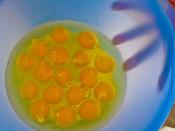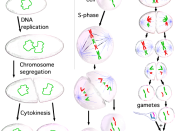Bacterial Cell Replication
Binary fission is the normal method of replication among bacteria; in this method of cell replication, the bacterial cells simply increase their cell mass slightly, replicate their cellular genome (DNA) and several other cell components, and then each cell divides equally into two cells.
Binary fission as a method of cell replication is very efficient, with division possible every 5 or 10 minutes! Consider the number of cells formed from 1 cell that divides every 10 minutes: in just a matter of hours millions of cells may form from just a single cell!
Conjugation is another means of bacterial "replication" although the cells do not really replicate as with binary fission. But conjugation is important for propagation of bacteria. In conjugation, two bacterial cells meet, form a bridge, and exchange pieces of their DNA. This allows for sharing of genes among bacteria, even among different genera. To learn more about conjugation and bacterial genetics click here.
Eucharistic Cell Replication
Budding is a simple method of cell replication used principally by yeasts (single celled fungi). Following DNA replication (genome replication), unequal splitting of a cell occurs to form two cells. Part of the cell literally pinches off, taking with it genetic material as well as some cytoplasm material.
Mitosis is the common form of cell replication for tissue growth and regeneration among all multi-cellular organisms. The image
During cell division, replication of cell genetic and cytoplasm material occurs, followed by a highly organized splitting of the cell's contents. The two cells formed following mitosis, called daughter cells (lower right image in the six-panel image seen above), are genetically identical, and each has about 1/2 the cell mass of the original cell; shortly, however, each daughter cell will increase its size to that of a typical cell of the...



-poor rating-
Attention: people if you rate my essays poor please inform me why so I can improve them.
What makes this essay bad? I know it's boring, however it is factual with scienfic terms, it would be helpful in a science class. Please explain your reason for the negative rating. Thank You.
2 out of 3 people found this comment useful.